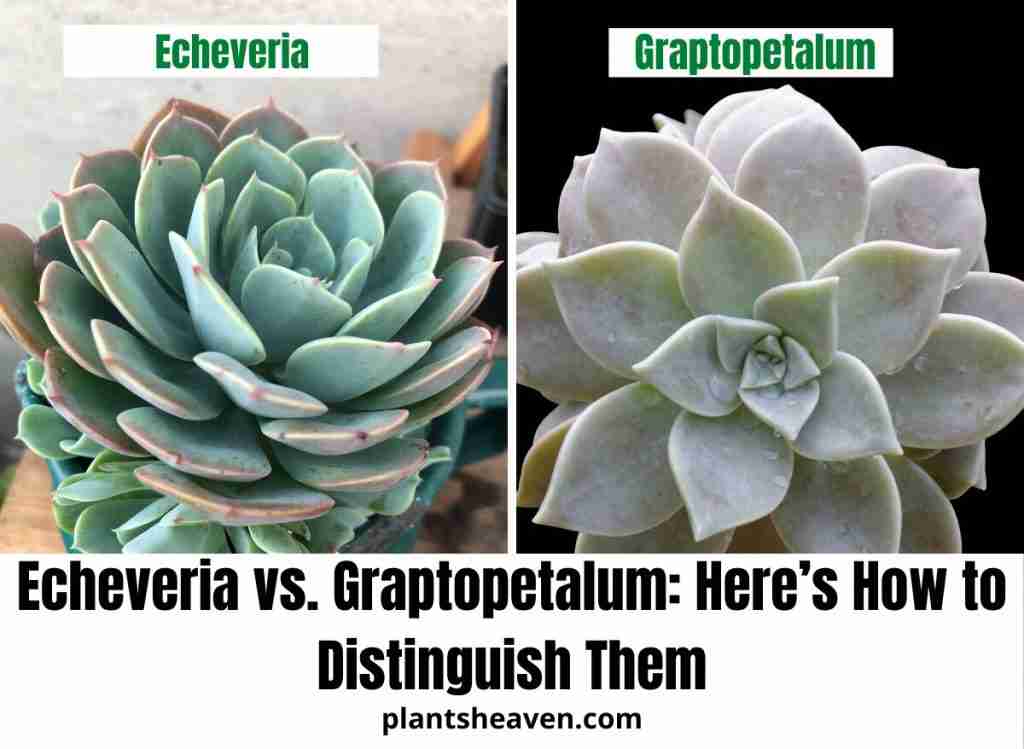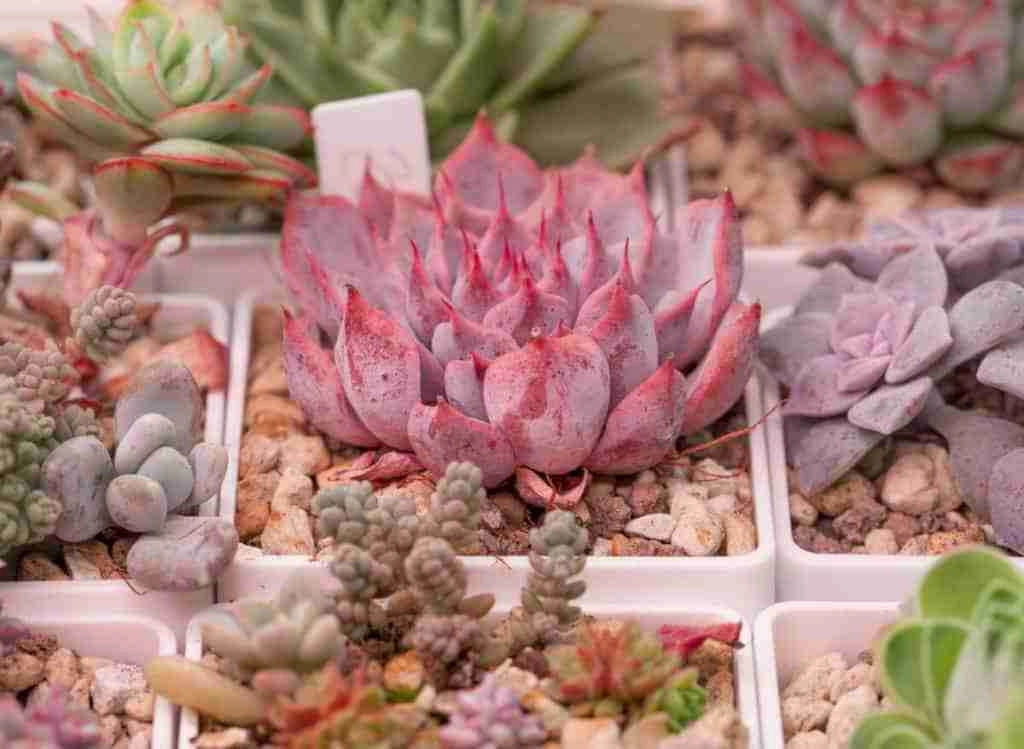
Because there are so many varieties of succulents available, many fans of these plants like to learn to identify the type of succulents by studying the characteristics of the plant itself. Some are so distinctive that they can be readily identified, while other succulents are so similar they can be easily confused with other varieties.
Echeveria (“Hen and Chicks”) and graptopetalum (“Ghost Plant”) have some key similarities, but if you look closely at some important features of each one, you’ll be able to tell them apart.
Both types of succulents are known for beautiful rosettes, thick leaves, and spring flowering. Echeveria is best identified by its rosettes on short stalks and spoon-shaped leaves. Graptopetalum is best identified by the trailing vines of rosettes that grow on long stalks and stems.
Although these very basic facts about the key features of echeveria and graptopetalum may help you tell them apart, you will probably need a bit more detailed information. Keep reading to learn how to really study the plant you are trying to identify and figure out which type of succulent it is.
See also: Haworthia Fasciata vs. Attenuata: How to Distinguish Them
Comparing Echeveria to Graptopetalum
Echeveria and Graptopetalum both originate in the Americas. Both feature rosettes and will usually flower annually. In addition, both grow in a desert environment but can still survive in colder and moister climates.
A careful study of each plant can help you identify which type of plant you are looking at based on its:
- Leaves
- Growing patterns
- Flowers
- Rosettes
Let us take a closer look at each of the characteristics of these lovely desert plants.
Examine Leaf Shape, Color, and Texture
Comparing the leaves on echeveria and graptopetalum is one useful way to determine which type of plant you are examining.
Leaf Shapes of Each Plant
The leaves on echeveria are shaped like a spoon, with smooth edges, and the leaves may have a narrow, pointed tip at the end. In contrast, the leaves on graptopetalum often take a more overall pointed or triangular shape.
Both echeveria and graptopetalum have fairly plump, chunky leaves compared to the thin leaves you may find on some succulents, so the thickness of the leaves will not help you tell these two types of plants apart.
That said, the leaves on graptopetalum are usually a bit thicker than those on echeveria. Still, the difference is one you probably won’t notice when you’re learning how to tell these plants apart.
Distinguishing Differing Leaf Colors
Leaf color can also be a helpful way to distinguish echeveria from graptopetalum. Echeveria leaves may have a very wide range of colors, including:
- Blue
- Gray
- Silver
- Yellowish-pink
- Even red
The leaves of the graptopetalum are more likely to be only:
- Green
- Gray
- Gray-white
Although when they grow in an open area with direct sunlight, they may be more yellow or pink.
How Leaf Texture is Different
Finally, the texture of the leaves can also help you distinguish echeveria from graptopetalum. The leaves of echeveria are almost always smooth and may have a waxy coating. Occasionally, echeveria has a fuzzy leaf.
In contrast, the leaves of graptopetalum are more distinctive. They are coated with pruinose, a white, powdery substance, which gives the plant a gray-white look that led to its nickname, “ghost plant.”
Be careful not to touch the leaves of a graptopetalum as you try to identify it; the pruinose can be damaged if you touch it.
See also: Treating Molybdenum Deficiency in Plants: Here’s How

Consider the Plant’s Growth Pattern
Echeveria is commonly known by the name “Hen and Chicks” because of the way it grows. The “hen” here is the main plant, or “mother plant.” As it grows, you’ll see smaller plants growing around the base of the main plant – the “chicks” clustering around the hen.
If you see this sort of growth pattern, you are probably looking at echeveria, although some other succulents members of the Crassulaceae family also demonstrate this pattern.
The most notable aspect of the graptopetalum’s growth pattern is its long, vinelike stems. While the echeveria, a more mature plant, can also grow long stems, the echeveria’s stem will grow tall. In contrast, the graptopetalum’s long stems will hang down over the edges of your pot or planter or spread along the ground surface if it’s growing in the ground.
In addition to the growth and stem type pattern, you might want to look at the size of the plant to help you identify it. Of course, you may not know how mature the specific plant you’re examining is, so the plant’s size may not tell you much.
However, it may be helpful to know that graptopetalum can grow anywhere from 6 inches tall to a foot tall and in 14-to-20-inch wide clusters of plants. Echeveria is generally smaller, maxing out at 12 inches high and 12 inches wide.
In other words, a very large plant is probably graptopetalum. Still, there is a significant overlap in the sizes of the two types of plants, and overall size may not be helpful in distinguishing one from the other.
See also: Succulents with Long Stems: Here’s What to do About Them
Compare the Plants’ Flowers
Both echeveria and graptopetalum flower annually, in the spring and early summer. In addition, they generally have similarly colored flowers (white, orange, pink, red, or yellow).
However, there is one key difference in the flowers that will help you properly identify which type of plant you are investigating:
- The flowers on echeveria are bell-shaped
- The flowers on graptopetalum are star-shaped
Of course, you can only use flowers to distinguish the plants if it’s the right time of year!
Measure the Rosettes
Determining the size of the rosettes on the succulent may help distinguish echeveria from graptopetalum, but not always. The rosettes on echeveria are generally between ¾-inch and 20 inches in diameter, which is a significant range!
In contrast, the rosettes on graptopetalum have a much smaller size range, growing between 2 and 5 inches in diameter.
Because this latter range lies within the size range, you’d see on echeveria, if you see a plant with a 2- to 5-inch rosette, you cannot tell from the general size which type of plant you’re perusing.
However, if the rosette is smaller than two inches or larger than five inches, the plant is likely echeveria, not graptopetalum.
See also: How to Make an Aeonium Branch Out: 5 Things to Know
Quick Reference Comparison Table
This summary table provides a quick way to compare echeveria to graptopetalum across several different dimensions discussed in this article.
| Echeveria | Graptopetalum | |
| Leaf shape | Spoon-shaped, smooth edges, sometimes narrow pointed tip | Rounded tip or larger pointed tip/triangle shape |
| Leaf color | Gray, green, blue, silver, red, pink | Whitish-gray, pale blue, gray-green |
| Leaf texture | Smooth, waxy, sometimes fuzzy | Covered in white powder (pruinose) |
| Stem growth pattern | Generally short stems; longer stems stand up tall | Long stems that grow across the ground or hang down over the side of the container |
| Flowers | Bell-shaped | Star-shaped |
| Rosette size | ¾-inch to 20 inches | 2 to 5 inches |
The Plant May Be A Hybrid
Echeveria and graptopetalum are such similar plants that they are sometimes cross-pollinated to grow the hybrid plant x Graptoveria. The “x” in the name signifies a hybrid succulent.
So, it is not surprising that it can be hard to tell these two types of succulents apart.
See also: Top 16 Best Vegetable Gardening Books For Beginners
Closing Thoughts
With the guidance provided here, you have several key factors you can check for if you want to determine whether a given plant is echeveria or graptopetalum.
Clear photos of the two types of plants (and their many varieties) can provide additional guidance as you work on your identifications. If you want to consult photos, you can find a great echeveria gallery here. As a bonus, this gallery also provides care tips should you try to grow an echeveria at home. Or, look at this graptopetalum gallery for examples of the ghost plant.
Whether you can correctly identify the succulent you are looking at, you will surely enjoy the plant’s beauty and unique qualities!

